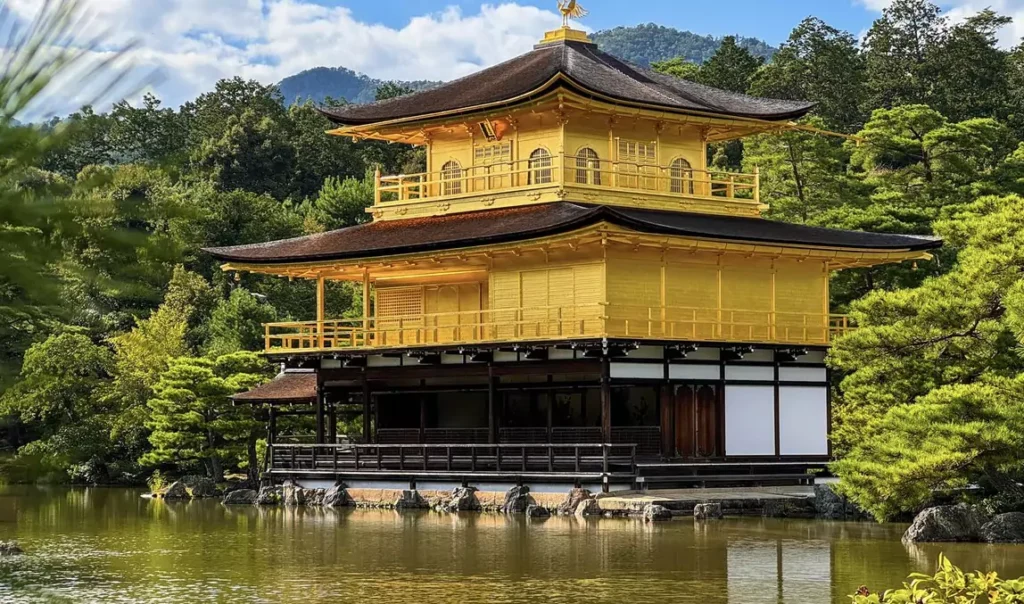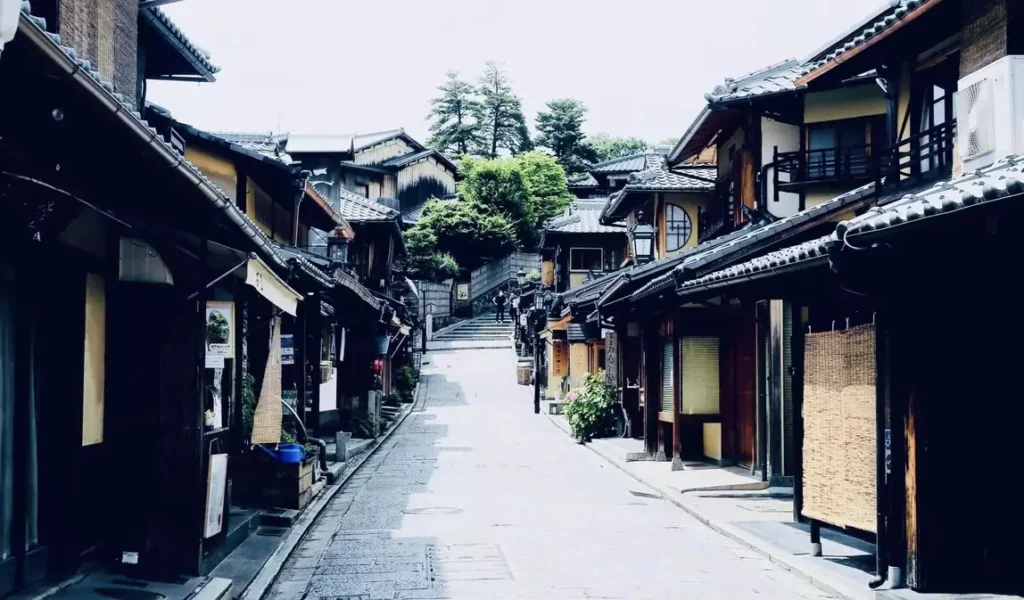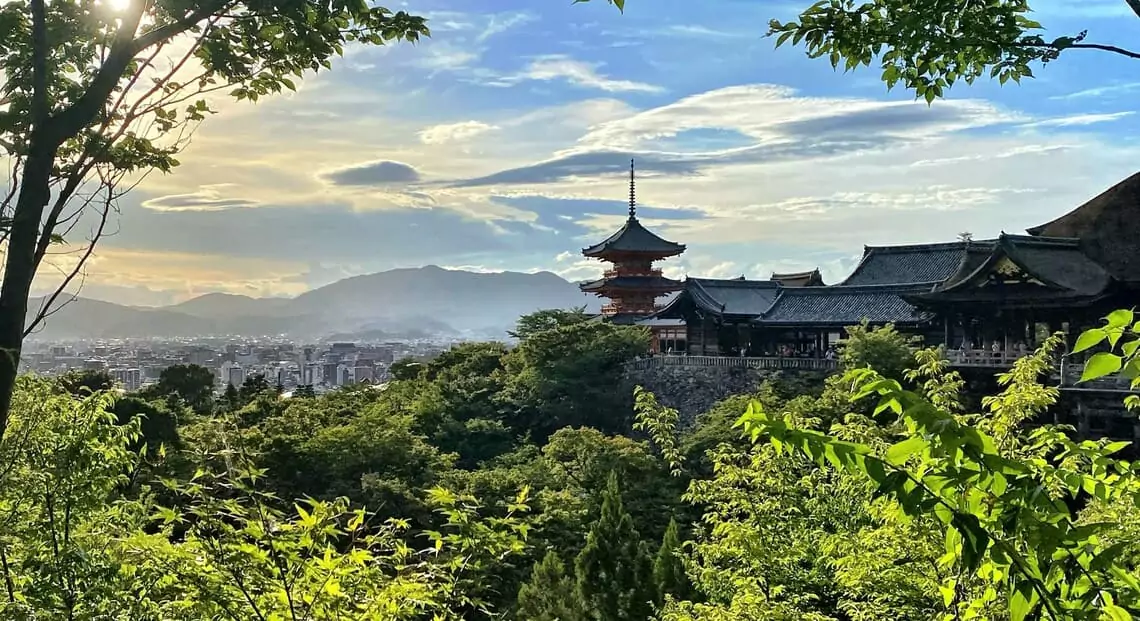Welcome to Kyoto! This city was the capital of Japan from 794 to 1868 and the birthplace of many of Japan’s traditional arts and crafts. It is Japan’s number two tourist destination (only the Tokyo metropolitan area has more visitors). Filled with stunning temples, shrines, Japanese gardens, traditional teahouses, and the renowned historic Bloord, Kyoto is a must-see for visitors to Japan.
The city is situated in a large valley and is surrounded by mountains, which provide in excess of 100 hiking paths that can be enjoyed by hikers of all levels. Interestingly, more than 17 UNESCO World Heritage Sites are located in Kyoto and together they attract millions of visitors from all around the world.
Upon arrival in Kyoto, there are many different visiting options, each of them with its highlights. We would like to provide the best things to do in Kyoto for a relaxing and cultural getaway. Learn how to prioritize rest and rejuvenation in this enchanting city without breaking the bank.
1. Visit the Kinkakuji Temple (Golden Pavilion)

One of Kyoto’s most iconic landmarks, Kinkakuji, also known as the Golden Pavilion, is a must-see for any traveler. This stunning Zen temple is renowned for its top two floors, which are adorned in brilliant gold leaf, creating a breathtaking reflection in the surrounding Mirror Pond.
Originally built as a retirement villa for Shogun Ashikaga Yoshimitsu in the late 14th century, Kinkakuji was converted into a Zen temple after his death. Its rich history adds depth to your visit, and audio guides are available to provide context and stories about the temple’s past.
The temple is set within a beautifully landscaped garden that features walking paths, ponds, and small islands. Seniors can take a stroll around the pond, enjoying the tranquil atmosphere and the picturesque views of the pavilion reflected in the water.
The site has benches for resting, allowing visitors to take their time soaking in the beauty around them.
To avoid crowds, consider visiting early in the morning or later in the afternoon. The temple is open year-round from 9:00 AM to 5:00 PM, and the entrance fee is a modest 400 yen (about $4).
2. Explore the Arashiyama Bamboo Grove

The Arashiyama Bamboo Grove is a magical experience that transports visitors into a serene world of towering bamboo stalks. This enchanting grove is located in the Arashiyama district, which is also home to other attractions.
Walking through the bamboo grove feels like stepping into another realm. The gentle rustling of bamboo leaves and the soft light filtering through the stalks create a peaceful ambiance. The paths are well-maintained and suitable for seniors, allowing for leisurely exploration.
After enjoying the bamboo grove, consider visiting the nearby Iwatayama Monkey Park or the picturesque Togetsukyo Bridge. Both locations are within walking distance and offer beautiful views of the surrounding mountains and river.
The main paths in the bamboo grove are generally flat and easy to navigate. However, some side paths may be uneven, so it’s advisable to stick to the main walkway for a more comfortable experience.
Related:
3. Relax at the Tenryuji Temple

Tenryuji Temple, a UNESCO World Heritage Site, is another highlight of Kyoto. Known for its beautiful gardens and serene atmosphere, this temple is a perfect spot for seniors looking to relax and enjoy nature.
The temple features a beautifully designed main hall that offers stunning views of the surrounding gardens and mountains. The architecture reflects the simplicity and elegance of Zen design, providing a peaceful setting for contemplation.
The temple’s gardens are a masterpiece of landscape design, featuring a pond, walking paths, and meticulously arranged plants. Seniors can enjoy a stroll through the gardens, taking in the seasonal beauty of cherry blossoms in spring and vibrant foliage in autumn.
Tenryuji often hosts traditional tea ceremonies, allowing visitors to experience Japanese culture firsthand. Participating in a tea ceremony can be a delightful way to relax and learn about this important aspect of Japanese tradition.
4. Discover Nijo Castle

Nijo Castle, a UNESCO World Heritage Site, is a must-see for anyone visiting Kyoto. Built in the early 17th century as the residence of Tokugawa Ieyasu, the first shogun of the Edo Period, this castle showcases stunning architecture and beautiful gardens.
As you stroll through the castle grounds, you’ll encounter the Ninomaru Palace, where the shogun would receive guests. The palace is famous for its “nightingale floors,” which chirp when walked upon, serving as a security measure against intruders. Seniors can enjoy guided audio tours available in English, providing insights into the castle’s rich history.
The castle grounds feature expansive gardens filled with cherry blossom trees, which bloom beautifully in spring. The gardens are designed for leisurely walks, with plenty of benches for resting. Plan your visit during cherry blossom season (late March to early April) for a truly breathtaking experience.
Nijo Castle is equipped with ramps and elevators, making it accessible for seniors with mobility challenges. The entrance is conveniently located near Nijojo-mae Station on the Tozai Line, ensuring easy access to and from the site.
5. Explore the Fushimi Inari Shrine

Fushimi Inari Shrine is one of Kyoto’s most iconic landmarks, renowned for its thousands of vibrant red torii gates that wind up the sacred Mount Inari. This shrine is dedicated to Inari, the Shinto god of rice, and is a significant spiritual site in Japan.
While the full hike to the summit can be strenuous, seniors can enjoy the lower trails, which are lined with beautiful torii gates and offer stunning views of the city. The lower paths are well-maintained and provide ample opportunities for photos and reflection.
As you explore the shrine, take time to appreciate the various offerings and the serene atmosphere. The site is particularly peaceful in the early morning, making it a wonderful time for contemplation.
The main shrine area is accessible, and there are plenty of spots to sit and enjoy the surroundings. For those who prefer not to hike, the lower trails still provide a rich experience without the physical exertion.
6. Stroll Through the Gion District

Gion, Kyoto’s famous geisha district, is a charming area that transports visitors back in time. With its traditional wooden machiya houses, teahouses, and narrow lanes, Gion is the perfect place to experience Kyoto’s cultural heritage.
Strolling through Gion, seniors can enjoy the sights and sounds of this historic district. Look out for geisha and maiko (apprentice geisha) as they make their way to appointments in the evening. For a deeper understanding of this unique culture, consider participating in a traditional tea ceremony or attending a performance at a local teahouse.
Gion is home to many shops selling traditional crafts, from kimono fabrics to pottery. Seniors can take their time browsing the stores and enjoying local delicacies at nearby restaurants. Be sure to try Kyoto-style kaiseki, a multi-course meal that showcases seasonal ingredients.
The streets of Gion are mostly flat and easy to navigate, making it accessible for seniors. There are also plenty of benches and cafes where you can take a break and soak in the atmosphere.
7. Discover the Nishiki Market

Nishiki Market, often referred to as “Kyoto’s Kitchen,” is a bustling food market that has been a staple of the city for centuries. Stretching approximately 400 meters, this narrow, covered street is lined with over 100 shops and stalls, each offering a variety of local delicacies, fresh produce, and unique culinary items.
As you wander through the market, you’ll encounter a vibrant array of foods, from fresh seafood and seasonal vegetables to traditional Kyoto sweets and pickles (tsukemono). Many stalls offer free samples, allowing you to taste before you buy. Be sure to try local specialties like yudofu (tofu hot pot) and matcha (green tea) treats.
Nishiki Market is not just about food; it’s a cultural hub where you can observe local life and traditions. The market has a rich history, dating back to the 14th century, and many of the shops have been run by the same families for generations.
The market is pedestrian-friendly, but it can get crowded, especially during peak hours. For a more relaxed experience, consider visiting in the late afternoon when the crowds thin out. The market is easily accessible via public transportation, with Shijo Station just a short walk away.
8. Explore the Kyoto National Museum

The Kyoto National Museum is a treasure trove of Japanese art and history, making it an excellent destination for seniors interested in culture and heritage. The museum houses an extensive collection of artifacts, including textiles, ceramics, and samurai armor, providing a comprehensive overview of Kyoto’s rich cultural legacy.
The museum features rotating exhibitions that highlight various aspects of Japanese culture, from ancient times to the present. The permanent collection showcases traditional crafts and art forms unique to Kyoto, including Kyo-yaki pottery and kimono textiles.
For seniors looking to enhance their visit, guided tours are available in English. These tours provide valuable context and stories behind the exhibits, making the experience more engaging.
The museum is open from 9:30 AM to 5 PM, with extended hours during special exhibitions. Visiting on weekdays can help you avoid larger crowds, allowing for a more peaceful exploration of the collections.
9. Relax at the Shosei-en Garden

Shosei-en Garden, also known as Shosei-en, is a tranquil oasis located near the Kyoto National Museum. This beautiful garden is a perfect place for seniors to unwind and enjoy the natural beauty of Kyoto.
The garden features meticulously landscaped grounds, complete with ponds, walking paths, and seasonal flowers. The serene atmosphere makes it an ideal spot for strolls and quiet reflection. The garden is particularly beautiful in spring when cherry blossoms bloom and in autumn when the leaves change color.
Shosei-en is associated with the Higashi Hongan-ji Temple and has a rich history dating back to the 17th century. The garden is designed in the traditional Japanese style, emphasizing harmony with nature.
The garden is easily navigable, with well-maintained paths and plenty of benches for resting. It’s a peaceful retreat from the hustle and bustle of the city, allowing seniors to relax and enjoy the beauty of their surroundings.
10. Stroll Through Maruyama Park

Maruyama Park is one of Kyoto’s most beloved green spaces, especially popular during cherry blossom season. This expansive park is perfect for seniors looking to enjoy nature, take leisurely walks, or simply relax in a beautiful setting.
The park is home to over 600 cherry trees, making it a stunning location for hanami (flower viewing) in spring. The sight of blooming cherry blossoms is breathtaking and offers fantastic photo opportunities.
Within the park, you’ll find the iconic Yasaka Shrine, which is worth a visit. The shrine is particularly beautiful in the evening when it is illuminated. The park often hosts seasonal festivals and events, providing a taste of local culture.
While the cherry blossoms in late March to early April are a highlight, Maruyama Park is beautiful year-round. Autumn foliage in November is also stunning, with vibrant colors painting the landscape.
11. Experience the samurai & ninja museum with experience

For seniors interested in Japan’s fascinating history, the SAMURAI & NINJA MUSEUM offers a unique and interactive experience. This museum provides insight into the lives of samurai and ninja, two iconic figures of Japanese culture.
The museum features various displays of samurai armor, weapons, and ninja tools. Seniors can engage with interactive exhibits, including trying on samurai armor and participating in ninja training activities. These hands-on experiences are not only fun but also educational.
The museum often hosts live demonstrations of martial arts and traditional Japanese performances, allowing seniors to witness the skills and techniques of samurai and ninja firsthand.
The museum is open daily, and visiting in the morning can help avoid crowds. Check their schedule for any special events or performances that may enhance your experience.
12. Relax at Kiyomizudera Temple

Kiyomizudera Temple, a UNESCO World Heritage site, is one of Kyoto’s most famous landmarks. Known for its stunning wooden stage that juts out over the hillside, this temple offers breathtaking views of the city and surrounding landscapes.
The main hall of Kiyomizudera is built on stilts, providing spectacular views, especially during cherry blossom season and autumn when the foliage is vibrant. The temple is surrounded by beautiful gardens, making it a peaceful place to relax and take in the scenery.
Founded in 780, Kiyomizudera is steeped in history and is dedicated to Kannon, the goddess of mercy. The temple grounds include several smaller shrines and the famous Otowa Waterfall, where visitors can drink from three streams, each said to grant different benefits.
The approach to Kiyomizudera is lined with charming shops and tea houses, allowing seniors to enjoy a stroll through the historic Higashiyama district. The paths are mostly gentle, making it accessible for those with mobility concerns.
13. Stroll Through Sannenzaka & Ninenzaka

Sannenzaka and Ninenzaka are two picturesque, sloping streets in the Higashiyama district, leading up to the famous Kiyomizudera Temple. These charming streets are lined with traditional wooden buildings, quaint shops, and tea houses, offering a glimpse into Kyoto’s past.
As you walk along these cobblestone streets, you’ll be surrounded by the ambiance of old Kyoto. The architecture features traditional Kyo-machiya (townhouses) that date back centuries, providing a beautiful backdrop for your stroll.
Both streets are home to around 60 shops and eateries, where you can find everything from handmade crafts and souvenirs to delicious local snacks. Be sure to try some matcha (green tea) ice cream or traditional sweets like mochi.
Many shops offer hands-on experiences, such as tea ceremonies or the chance to dress in traditional kimono. Participating in these activities can deepen your appreciation for Japanese culture.
14. Explore Pontocho Alley

Pontocho Alley is a narrow, lantern-lit street that runs parallel to the Kamo River, famous for its traditional teahouses and vibrant nightlife. This area is a cultural gem, offering a unique glimpse into Kyoto’s geisha heritage.
Pontocho is lined with restaurants offering a variety of dining options, from casual izakayas to upscale kaiseki (multi-course) meals. Many establishments have outdoor seating with views of the river, perfect for enjoying a meal while soaking in the atmosphere.
While wandering through Pontocho, you may spot geisha and maiko (apprentice geisha) heading to their appointments. The area is known for its traditional entertainment, and some restaurants offer performances that showcase this unique aspect of Kyoto culture.
The alley provides stunning views of the Kamo River, especially at sunset when the lanterns are lit. This creates a magical ambiance that is perfect for leisurely walks and photography.
Pontocho is lively in the evenings, making it an excellent spot for dinner. Visiting around sunset allows you to enjoy the transition from day to night and witness the area come alive with lights and activity.

